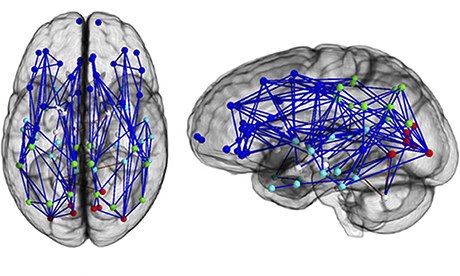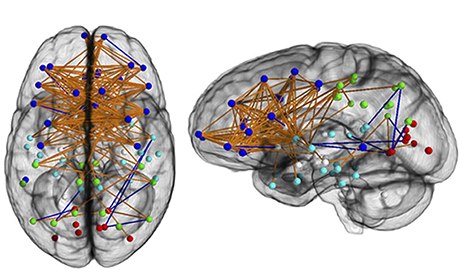
|
In the typical male brain (above), most connections run between the front and back of the same hemisphere, accounting for better spatial skills and motor control in men.
The typical female brain (below) is rich in neural connections across the left and right hemispheres, particularly at the frontal lobes, and this accounts for women’s superior verbal capacity. An interesting contrasting observation was the ‘Localisation of increased prefrontal white matter in pathological liars’ Yang, Y. L. et al. (2007) British Journal of Psychiatry 190: 174-175. |
|
Less Scientific Sexism– or –Observed DifferencesPublished in Heritage and Destiny magazine, issue 96, May-June 2020 |

|
|
A sequel to my recent ‘Scientific Sexism’ article provides an opportunity to explore more informally some sex differences in everyday life. That earlier article was confined to facts, demonstrable empirically, but here I will be less rigorous. The behaviours should be familiar, but such is the power of the mass media that it is possible for the obvious to be overlooked. An established stereotype can override what we see, because it falls outside a pre-conditioned frame, what is nowadays called “the narrative.”
This filtering process is comparable to how our vision works. Persons born blind who later suddenly regain their sight have great difficulty learning how to see. When we look at a chair say, we don’t see a bitmap like in a computer. We see a pattern and our brains fill in the gaps. The theory is that this is an “evolutionary short cut” which works very efficiently, most of the time. The many optical illusions which exist demonstrate the instances when this “quick and dirty” system fails. A visual system which worked with perfect accuracy would be extremely slow, if indeed the brain, powerful as it is, could process the huge amount of data involved, especially with moving images. Even computers use compression with less than perfect reproduction.
Several other “evolutionary short cuts” have been made; they work very efficiently but are prone to occasional error, and indeed exploitation. When a false stereotype is established and we see behaviour which conflicts with that pattern, in a similar way, our brain is unable to fill in the gaps and complete the picture. Then the observation or perception can be discarded like an inconsistent, overlooked clue in a murder mystery.
The supreme power of the mass media is its ability to impose a false perception of reality. This has been accomplished in large degree. The problem with normies is that they are unable to grasp the sheer enormity of the deception which for decades has been perpetrated against them. But I digress, and risk straying from my theme.
Much of the following is developed from Procedural Analysis, that dichotomous approach of mine in which every procedure (sequence of actions or decisions) is either masculine or feminine, according to whether it gives advantage in the male-female game. In this advanced study I hope to explore, or at least describe, a behaviour that has not been discussed hitherto.
A basic behaviour to start with is the typical male and female attitudes, the competitive and sympathetic responses. Suppose a woman meets up with a group of others and on arrival recounts some unpleasant experience she had on her journey. The other women will gather round and sympathise, offering reassuring words, “That must have been so awful” etc. Some might feign concern, if the female is not her favourite. By contrast if a man joins a group of men with a tale of misfortune, the likely response is “That’s nothing, once I...” and then will begin a round of tales of derring-do, each trying to out-do the other. Some might even exaggerate.
Mark Tyrell, a sort of self-help and hypnosis guru, made an interesting observation:
‘Male friends have told me they hate it when a woman asks them during a quiet moment: “What are you thinking?” Women find this a natural question because women tend to go quiet when they feel hurt or lied to. If a man is quiet, a woman may assume his silence indicates that he is upset. Men, on the other hand, stop communicating when they have a problem to solve.’
Another theme he explores is that emotions actually affect males more. It’s as if for females, emotions are something to be experienced, sometimes even relished, and to be expressed verbally, talked over and shared with others. For the male however, emotion impels him to action, and there is great potential for things to go seriously awry if he acts in an elevated emotional state. This leads to stress. The sound of a baby crying was played to young boys and girls and unexpectedly, it was the boys who quickly tried to shut off the sound and had raised levels of stress hormone. It also takes males longer to recover from stress. As Tyrell put it, strong emotion in the male “is a cue to action rather than discussion.”
Then we may look, as objectively as we can, at the absolutely enormous effort and expenditure women invest in making themselves attractive to men. With an increasingly feminine and feminized society comes a plethora of hairdressers, nail salons and eyelash parlours, plus the usual clothes and accessory shops. Some women spend tens of thousands on cosmetic surgery, but this is just the tip of women’s preoccupation with their physical appearance. Claims that this is due to inter-female rivalry can be dismissed, and in any case it is attractiveness to males that is the metric. A woman wearing lipstick is exaggerating, or simulating, a sexual signal. Women’s very form has been defined by men. Breasts need only to be a fraction of their size to fulfil the purpose of feeding young, this being readily confirmed by comparison with the breast size of numerous primate species. Women’s breasts are the size they are because men like them.
This forming by sexual preference is not just one-way. Females have been favouring as mates males with feminine traits for millennia, although the freedom in mate-selection they exercise currently has never been so great. This long process of sexual selection accounts for the existence of epicene males.
Another trait, more subtle, concerns the instinct to strike in the face of vulnerability. This is evidently another binary property, with the dichotomy between ‘animal nature’ (strike) and ‘civilised human nature’ (back off). A good illustration was an incident which occurred with a tiger in a zoo in Indonesia or somewhere. Its keeper had handled it since it was a cub and with that familiarity the tiger was always placid. One day the keeper was inside the compound repairing its fence and fell from his ladder, breaking his leg. Seeing his injured state and sensing his vulnerability, the big cat sprang and killed him.
A friend in Amsterdam recounted how he had been walking along a quiet road and passed a car parked at the side with some Arabic men sitting in it. Walking on, he half-stumbled on a flagstone or something and at this the men, who turned out to be Moroccans, emerged from the car and beat him up. This particular account is well-remembered, since it features in The Tyranny of Ambiguity, but is typical. A show of weakness inspires the urge to attack. Among civilised men the instinct is the opposite. In British prisons, criminals who prey on the elderly, the disabled or children are despised.
Darwin observed that women had more animal natures than men, with their greater reliance on intuition, emotionality, acuity of signals (shared by Negroes, he also said) and capacity for imitation (also shared). I would add speed of response and opportunism to the list.
The evolutionary competitor of White women is White men. Her opponent can also be children and other women, but her provider, and opponent in the ultimate game, the male-female game, is men. If there is tribal or racial conflict, or indeed almost any physical conflict, she is a bystander and becomes a spoil of war. This is certainly true of our evolutionary past and is just as true today. Of course in past ages she faced adversity such as childbirth and all the other hardships of the time, but the only opponent she had to manipulate was men. Manipulate them she must, because for as long as women have had undergarments men have been trying to get into them and the maiden who lost control of sex quickly found herself up the spout. That is, pregnant and socially shamed, burdened, alone or some combination of these. Whatever her environment, she faced serious consequences.
In reality, male and female are opposites and only in very limited circumstances do their interests coincide – when both combine to replicate each others’ genes. Most of the time, male and female interests conflict. With this single (but crucial) exception, their interests are diametrically opposed.
A counselling psychologist in Amsterdam I knew had many clients sent to him by the city. His female clients would express guilt about their actions involving children and animals but never concerning men. I’m reminded of a report some years ago that the BBC received more viewer complaints about the beating up of a teddy bear than real, actual violence. Women’s ‘attack on vulnerability’ switch does not operate on children, or cute fluffy animals, but it does operate on men. Though in the human case the assault is more likely to be verbal and/or psychological. It will often be performed under a pretext.
Applying this to our situation now, this means that when alien forces are undermining men, collectively demoralising and weakening them, when fourth generation warfare is underway and all manner of means are being employed to deter men from exercising any authority or control, women, in the main, will simply go along with it, and join in.
